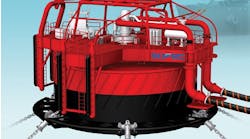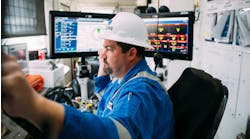SAFETY, ENVIRONMENTAL MANAGEMENT Safety procedures plan provides platform-to-platform uniformity
Program enhances confidence for new and contract
operations, maintenance
Wanda June Parker
Oryx EnergySteve Hanus
Mustang Engineering
The density of equipment aboard offshore production platforms makes uniform procedures for operations and control necessary for safe intervention. Oryx used a new uniform management practice on the High Island A-379-B platform deck being installed near the Flower Gardens reef sanctuary in the US Gulf of Mexico.A safety and environmental management program (SEMP) has been recommended by the American Petroleum Institute since 1993 as its recommended practice (API RP75). The program is endorsed by the US Mineral Management Service (MMS) in order to promote the safety and environmental protection of offshore operations on the US outer continental shelf.
The plan addresses the management of hazards associated with facilities design, construction, startup, operation, inspection and maintenance. Additionally, SEMP provides a means for ensuring that the program elements are properly utilized, documented, and available on location or at the operations office.
Although SEMP is a newly recommended program, its principles and concepts have been applied by many OCS operators for years. Many day-to-day operating procedures offshore follow guidelines incorporated into SEMP documents. SEMP's value, though, is to integrate available information and to provide a suitable framework for documentation and implementation of safety and environmental procedures tailored specifically to an operator's needs.
Oryx Energy and Mustang Engineering collaborated on such a program for Oryx, incorporating site-specific details for the company's High Island A-379-B production facilities off Texas. This particular platform was a new installation located within the four mile zone of the environmentally sensitive Flower Garden Banks National Marine Sanctuary.
Program
The complete SEMP program is segmented into 12 parts. With knowledge of the SEMP requirements, certain existing company operating procedures can be re-formatted and inserted into the appropriate section of the plan. Information not currently available can be modified from other programs, and when available, placed in the plan document as well. A brief synopsis of the program segments follows:Benefits
As with most other offshore operators, Oryx Energy has had written operations, safety, environmental and maintenance procedures in place for some time and available at each of its offshore facilities. Additionally, the company has employed managers specifically to oversee these procedures. How then, did the SEMP implementation benefit Oryx, and how will it similarly benefit other operators?The SEMP program provides an operator with a standard set of comprehensive guidelines for operating and controlling each of its offshore facilities. Since it is site specific, it further identifies those concerns particular to that facility. When used on Oryx platforms, it helped provide a uniformity of procedures that allowed company personnel to come on Oryx facilities and work with confidence.
Since many operators rely on contract personnel for certain maintenance and operations, SEMP provides a standard for their performing duties safely and without confusion. Once contractor personnel have been instructed on company SEMP particulars and know the whereabouts of the manuals on site, the workers can move among company platforms with an understanding of required procedures and potential hazards. This immediate knowledge saves both time and money, since extensive orientations at each location are not necessary before work commences.
For platform HI A-379-B, since it was a startup situation, the SEMP program was instituted during the platform's design phase. This enabled Oryx to enact minor design changes prior to installation, ultimately saving time and reducing startup costs.
In constructing its hazards analysis, Oryx followed a Mustang Engineering-prepared checklist developed for global use on all of the company's platforms and then applied to HI A-379-B simply by eliminating those elements non-applicable to that installation. This approach enabled Oryx to have an existing program for all future installations.
To verify the effectiveness of this SEMP segment, Oryx evaluated representative pieces of equipment on the platform and then employed an independent engineer to conduct an unbiased hazards analysis. This method of verification enabled Oryx to identify and correct minor issues that warranted modifications in procedure.
The management of change procedure provided Oryx with a clear mechanism for internal communication and offered a means of keeping any changes well documented. Since the field superintendents are responsible for approving changes, this segment of SEMP designated singular responsibility and placed accountability for document updates at the field level.
Oryx organized its formal startup review into two approaches. It provided a checklist for field personnel, enabling them to readily pre-condition and commission equipment at startup. Additionally, it assigned a company inspection team - including safety and environment specialists and mechanical, facilities and operations engineers - to conduct a platform walk-through prior to startup, promoting a quicker and safer startup.
To adhere to SEMP's segment concerning emergency response and control, the company annually conducts a minimum of two drills for its offshore operations. These real-time exercises cover all aspects of the plan. The scenario varies for each drill and involves a broad spectrum of company employees, including administrative personnel, management, field personnel, and the public relations crisis response team. Specific parts of SEMP implemented initially at the HI A-379-B platform included such details as the names and phone numbers of individuals to be contacted in any form of emergency.
A recent survey conducted by API assessing the implementation status of RP75 indicated that almost 95% of US Gulf of Mexico operators are already in the process of implementing the plan to varying degrees. SEMP has not yet become a mandatory requirement for offshore operators. If it parallels the OSHA CFR 1910.119 for onshore facilities, however, it could ultimately become a requirement. In the meantime, it can be a very useful tool for providing cost savings while increasing personnel safety.
Whether it becomes mandatory or not, to be most effective and beneficial, all aspects of the plan need to be thoroughly reviewed, involving management and staff participation. The implemented program needs to include enough detail to be useful to field personnel, but also be flexible enough to include information that is pertinent to daily operation. The involvement of a specialist in SEMP and manuals preparation should be considered in order to prepare the most appropriate document.
AUTHORS:
Wanda June Parker, P.E., is manager of offshore environmental and regulatory affairs for Oryx Energy. She is a graduate of Texas A&M and a registered engineer in Texas. She has eight years experience in the environmental and regulatory segment of the industry with Oryx, much of it devoted to offshore.
Steve Hanus is a consulting engineer for Mustang Engineering in Houston. He has more than 25 years experience in the oil and gas, petrochemical, chemical, and other process industries. He has significant experience in developing compliance manuals for OSHA CER 29 Part 1910, SEMP, and facilities operating manuals.
Copyright 1997 Offshore. All Rights Reserved.




